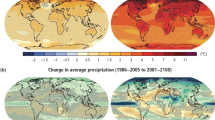Abstract
Natural and man-made hazards are often associated with costly damages to civil infrastructure systems, such as buildings, bridges, Levees, dams, pipelines and offshore structures of all types. The lack of high-quality field and lab data of soil system response have eluded researchers and practitioners until recently. Recent advancements in physical modeling facilities (centrifuge and full scale) and advancement in remote sensing technology are leading to a new reality for the health assessment of soil–structure systems. This new reality is leading to a paradigm shift in the evaluation and modeling of soil–structure systems. Physical modeling, remote sensing and computational simulations are destined to replace the current empirical approaches and will ultimately become the main tool for analysis and design of soil–structure systems. The paper discusses the results of recent research studies utilizing physical modeling to simulate the response of critical soil–structure systems to natural and man-made hazards.














Similar content being viewed by others
References
Abdoun T, Bennett V, Danisch L, Shantz T, Jang D (2007) Field installation details of a wireless shape-acceleration array system for geotechnical applications. In: Sensors and smart structures technologies for civil, mechanical, and aerospace systems, Proceedings of SPIE, San Diego, Calif, USA
Abdoun T, Bennett V, Dobry R, Thevanayagam S, Danisch L (2008a) Full-scale laboratory tests using a shape-acceleration array system. In: Proceedings of the 4th Decennial Geotechnical Earthquake Engineering and Soil Dynamics Conference, Geotechnical Special Publication, Sacramento, Calif, USA
Abdoun T, Bennett V, Danisch L, Barendse M (2008b) Real-time construction monitoring with a wireless shape-acceleration array system. In: Proceedings of the GeoCongress Characterization, Monitoring, and Modeling of GeoSystems, Geotechnical Special Publication, New Orleans, La, USA, pp 533–540
Abdoun T, Gonzalez MA, Thevanayagam S, Dobry R, Elgamal A, Zeghal M, Mercado VM, El Shamy U (2013) Centrifuge and large scale modeling of seismic pore pressures in sands: a cyclic strain interpretation. J Geotech Geoenviron Eng ASCE 139(8):1215–1234
Bennett V, Abdoun T, Zeghal M, Koelewijn A, Barendse M, Dobry R (2011) Real-time monitoring system and advanced characterization technique for civil infrastructure health monitoring. Adv Civ Eng. doi:10.1155/2011/870383
Dobry R, Abdoun T (2017) Research findings on liquefaction triggering in sands during earthquakes. J Geotech Geoenviron Eng (in press)
El-Ganainy H, Tessari A, Abdoun T, Sasanakul I (2014) Tactile pressure sensors in centrifuge testing. Geotech Test J 37(1):20120061
El-Sekelly W (2014) The effect of seismic preshaking history on the liquefaction resistance of granular soil deposits, PhD thesis, Rensselaer Polytechnic Institute, Troy, NY, USA
El-Sekelly W, Abdoun T, Dobry R (2016) Liquefaction resistance of a silty sand deposit subjected to preshaking followed by extensive liquefaction. J Geotech Geoenviron Eng. doi:10.1061/(ASCE)GT.1943-5606.000144404015101
El-Sekelly W, Dobry R, Abdoun T, Steidl J (2016) Centrifuge modeling of the effect of preshaking on the liquefaction resistance of silty sand deposits. J Geotech Geoenviron Eng. doi:10.1061/(ASCE)GT.1943-5606.000143004016012
Gonzalez MA (2008) Centrifuge modeling of pile foundation response to liquefaction and lateral spreading: study of sand permeability and compressibility effects using scaled sand techniques. PhD Thesis, Rensselaer Polytechnic Institute, Troy, NY
Paikowsky SG, Hajduk EL (1997) Calibration and use of grid-based tactile pressure sensors in granular material. Geotech Test J 20(2):218–241
Palmer MC, O’Rourke TD, Olson NA, Abdoun T, Ha D, O’Rourke MJ (2009) Tactile pressure sensors for soil-structure interaction assessment. J Geotech Geoenviron Eng 135(11):1638–1645
Peck RB (1979) Liquefaction potential: science versus practice. J Geotech Eng ASCE 105(3):393–398
Podoloff RM, Benjamin M (1989) Tactile sensor for analyzing dental occlusion. SOMA Eng Hum Body 3(3):1–6
Springman S, Nater P, Chikatamarla R, Laue J (2002) Use of flexible tactile pressure sensors in geotechnical centrifuges. In: International conference on physical modeling in geotechnical engineering, St Johns, Canada, pp 113–118
Acknowledgements
The authors are very grateful to several colleagues that provided extremely valuable help and input to this paper. They are: V. Bennet, R. Dobry, J. Steidl, S. Thevanayagam, and M. Zeghal. They also thank their current and former students and collaborators as well as the staffs at RPI for their invaluable contributions to the research presented here. They are also extremely grateful to the National Science Foundation (NSF) and Network for Earthquake Engineering Simulation (NEES), for their support over a number of years.
Author information
Authors and Affiliations
Corresponding author
Additional information
This paper was selected from GeoMEast 2017—Sustainable Civil Infrastructures: Innovative Infrastructure Geotechnology.
Rights and permissions
About this article
Cite this article
Abdoun, T., El-Sekelly, W. Recent advances in physical modeling and remote sensing of civil infrastructure systems. Innov. Infrastruct. Solut. 2, 44 (2017). https://doi.org/10.1007/s41062-017-0078-3
Received:
Accepted:
Published:
DOI: https://doi.org/10.1007/s41062-017-0078-3




